|
80x5 -
240x3 -
240x4 -
320x1 -
320x2 -
320x3 -
640x1 -
640x2
Set display option above.
Click on
images to enlarge. |
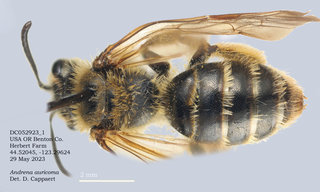
© Copyright source/photographer
· 9
Andrena auricoma, female, dorsal, Herbert, DC |
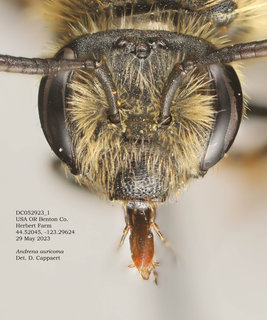
© Copyright source/photographer
· 9
Andrena auricoma, female, head, Herbert, DC |
|
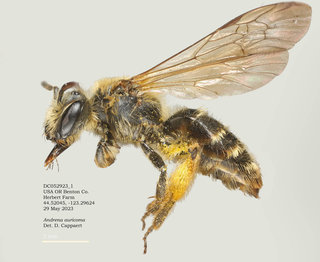
© Copyright source/photographer
· 9
Andrena auricoma, female, lateral, Herbert.DC |
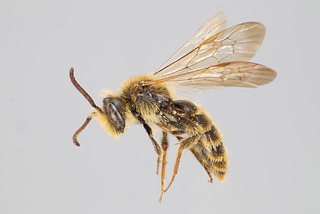
© Copyright Laurence Packer 2014
· 7
Andrena auricoma MALE CFP |
|
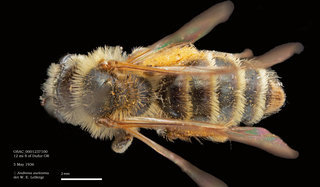
David Cappaert · 6
Andrena auricoma, female, dorsal, OSAC |
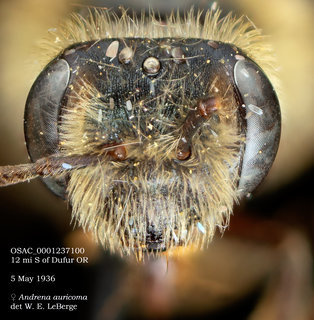
David Cappaert · 6
Andrena auricoma, female, head, OSAC |
|
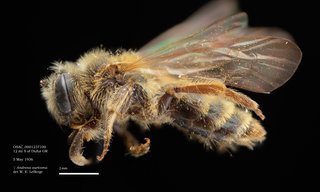
David Cappaert · 6
Andrena auricoma, female, lateral, OSAC |
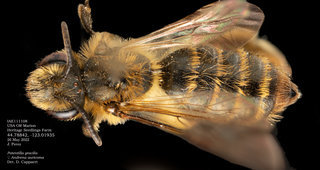
David Cappaert · 5
Andrena auricoma, female, dorsal, IAE |
|
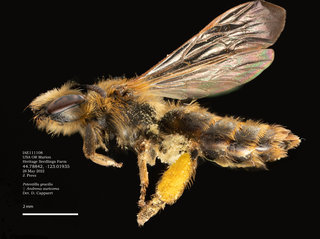
David Cappaert · 5
Andrena auricoma, female, lateral, IAE |
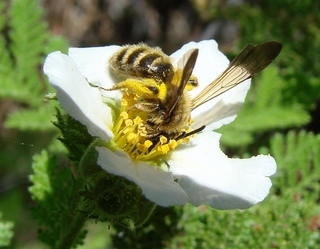
© Copyright John Ascher, 2006-2014
· 4
Andrena auricoma, bee |
|
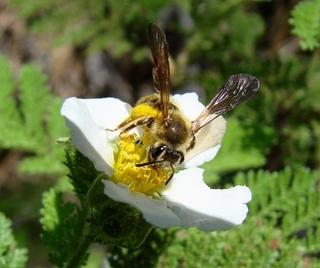
© Copyright John Ascher, 2006-2014
· 4
Andrena auricoma, bee |
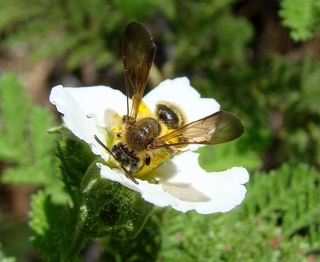
© Copyright John Ascher, 2006-2014
· 4
Andrena auricoma, bee |
|
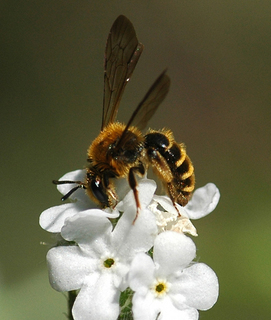
Hartmut Wisch · 1
Andrena auricoma |
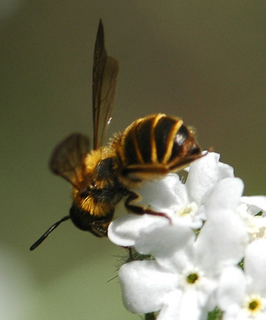
Hartmut Wisch · 1
Andrena auricoma, back |
|
Overview |
Reprinted with permission of the American Entomological Society from:
LaBerge, W. E., Ribble, D. W. 1975. A revision of the bees of the genus Andrena of the Western Hemisphere. Part VII. Subgenus Euandrena. Transactions of the American Entomological Society 101: 371-446.
Please report text errors to: leah at discoverlife dot org.
This small western species is very similar to A, astragali but can be separated from the latter by its smaller size, rhomboidal and feebly emarginate labral process, and its shinier terga. Some males of auricoma resemble certain males of chlorura except that the auricoma males have the tergal fasciae more pronounced. Like astragali, this species is relatively rare outside of California.
FEMALE. MEASUREMENTS AND RATIOS. — N = 20; length, 8-10 mm; width, 2.5-3.5 mm; wing length, M = 3.68 ± 0.180 mm; FL/FW, M = 1.01 ± 0.005; FOVL/FOVW, M = 4.33 ± 0.077.
INTEGUMENTAL COLOR. — Black with same exceptions as in astragali but wing membranes usually less infumate, yellow to yellowish-brown and tergal apices often more narrowly hyaline.
STRUCTURE. — Antenna as in astragali but flagellar segments 4 and 5 slightly broader than long. Eyes each about four times as long as broad, inner margins converging towards mandibles. Galea as in astragali. Maxillary palpus as in astragali but segmental ratio about as 0.9:1.0:0.9:0.8:
0.7:0.7. Labial palpus as in astragali but ratio about as 1.0:0.6:0.4:0.5. Labral process moderately large, rounded in outline or rhomboidal, with weak apicomedian emargination; labrum below process as in astragali. Clypeus rounded from side to side, short with small round punctures (larger in apical half) separated mostly by one-half to one or two puncture widths, sparser in basal half and medially, not gibbous apically; surface dulled at least in basal half by reticular shagreening. supraclypeal area, face above antennal fossae and genal area as in astragali. Facial fovea narrow, extending below to a line at lower margins antennal fossae or slightly below, separated from lateral ocellus by one and one-third to one and one-half ocellar diameters. Vertex above lateral ocellus shorter than one ocellar diameter, sculptured as in astragali.
Thoracic form and sculpturing as in nigrihirta and astragali but propodeum outside of dorsal enclosure with distinct punctures separated by one-half to one puncture width, surface finely tessellate. Wing venation, tibial spurs and tarsal claws as in nigrihirta; vannal lobe hind wing broad, but usually no more so than in caerulea.
Metasomal terga usually shiny, distinctly punctate with punctures separated by one-half (on discs of terga 2-4 in coarsely punctate specimens) to two or three (on discs of tergum 1 and terga 2-4 of weakly punctate specimens) puncture widths; apical areas with basal halves with small crowded piliferous punctures; surfaces usually unshagreened, shiny, less often lightly shagreened on basal halves of discs. Pygidial plate as in nigrihirta but more acute apically. Sterna as in nigrihirta but punctures slightly coarser.
VESTITURE. — In general yellow to pale ochraceous and generally distributed as in astragali; terga 1-5 with complete apical fasciae of long hairs. Pollen-collecting hairs as in nigrihirta.
MALE. MEASUREMENTS AND RATIOS. — N = 20; length, 6-9 mm; width, 1.5-2.5 mm; wing length, M = 3.10 ± 0.170 mm; FL/FW, M = 1.03 ± 0.005; FS1/FS2, M = 1.13 ± 0.031.
INTEGUMENTAL COLOR. — As in female but wing membranes more hyaline, often infumate only at tips and/or in marginal cell; hind tibia less often orange; clypeus often with exceedingly faint violaceous reflections.
STRUCTURE. — Antenna much as in astragali but scape length equal 10 first two and one-half flagellar segments or slightly more, flagellar segment 1 being no longer or only slightly longer than segment 2, segment 2 quadrate or slightly longer than broad. Eyes as in female. Galea as in astragali but segmental ratio about as 0.8:1.0:0.8:0.8:0.7:0.8. Labial palpus as in astragali but ratio about as 1.0:0.6:0.4:0.6. Labrum as in female but process usually more distinctly bidentate, but not as broadly quadrate nor sharply bidentate as in astragali. Clypeus as in female but usually punctures more obscured by shagreening. Supraclypeal area, face above antennal fossae, genal area and vertex as in female.
Thoracic form and sculpturing as in nigrihirta; propodeum outside of enclosure with distinct punctures as in female (unlike astragali); vannal lobe hind wing broad, as in nigrihirta or in female.
Metasomal sculpturing as in female but discs of terga 1-5 with punctures usually as in less coarsely punctate females, rarely with punctures large and crowded and basal halves of apical areas with small punctures present but sparser than in female. Sternal sculpturing as in nigrihirta.
Terminalia as in Figures 70-71; note the following: genital capsule as in nigrihirta: capsule and plates without unusual features found in astragali.
VESTITURE. — In general as in astragali: terga 1-5 usually with complete apical fasciae of long hairs (often worn medially but punctures of basal halves of apical areas attest to former presence), sternal vestiture as in nigrihirta but subapical fimbriae absent.
VARIATION. — The sculpture of the clypeus and of the metasomal terga varies considerably in both sexes as described above. However, this variation is not at all geographically coordinated and extremes often occur within a single series of individuals collected at the same time and place.
The vestiture varies in color from deep brownish-yellow through shades of yellow and ochraceous to white, again without geographical order. No specimens of auricoma have come to our attention with head hairs all or largely black, as in astragali, but males frequently have dark brown hairs on the face near the inner margins of the compound eyes.
Two females from Logan, Utah, are unusual in having much more of the integument red or yellow in color. In these two females the scapes are a bright yellow and the apical part of the clypeus is rufescent. The color of these females is so striking that they were at first regarded as representing a new intermontane species. No additional material has come to hand similar to the Utah specimens and other specimens appear intermediate in color between these and the more normal females.
|
|
|
Names | |
|
|
| Supported by | |
Updated: 2024-04-23 11:14:22 gmt
|